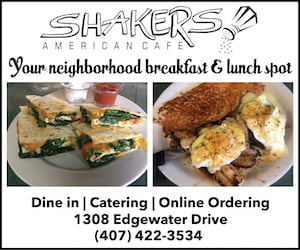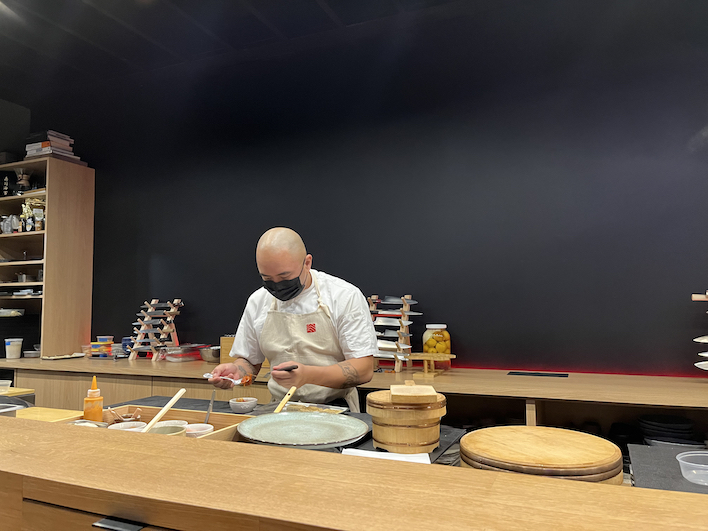
The Japanese dining experience known as omakase, wherein diners, not presented a menu, turn themselves over to the whim of the chef, is not new to Orlando. It has been an option at sushi restaurants for many years. (This concept isn’t exclusive to sushi restaurants, either – think a degustation or chef’s tasting menu, such as that at Victoria & Albert’s chef’s table.)
What is relatively new to the area is the omakase-only restaurant, offering an exclusive and intimate dining experience. Well, intimate in the sense that you’re among fewer than a dozen customers seated next to each other at a sushi counter but all having the same culinary adventure.
Kadence was the first to present this concept full time to Central Florida, and was awarded the Best Restaurant Overall Foodster Award in 2019. Soseki Modern Omakase came on the scene in March of ’21.
There are several similarities between the two. Both occupy indistinct buildings with little or no signage – walk-in diners aren’t allowed so there’s no need to try to draw people in; there’s also no published phone number. Each has an attractive interior decor and each has limited seating – nine for Kadence and 10 for Soseki – at a sushi-style bar (sans the see-through refrigerated container seen in typical sushi bars) with .
Also, you don’t make a reservation, you buy a ticket, a nonrefundable one. (And an expensive one, too, but more about that in a moment.)
One other similarity: Both are staffed by young, exuberant professionals who are passionate about the quality and creativity of what they present to their guests.

At Soseki, the able crew is led by Mike Collantes, pictured at top, who has been involved in other local ventures, including Taglish, the Filipino food stall at Lotte Market, and Perla’s Pizza, which became Ziggie’s Pizza when Collantes left that partnership. At Soseki, he is joined by chefs CJ Tokudaiji, Kevin Abanilla and Mike Vang; Benjamin Coutts serves as the beverage director.
Guests at Soseki are seated side-by-side at a mid-height bar with a higher bar separating them from the chefs. It’s on this higher counter that the various courses – 15 or more depending on how you count them – are placed for the diners to pull down and put in front of themselves.
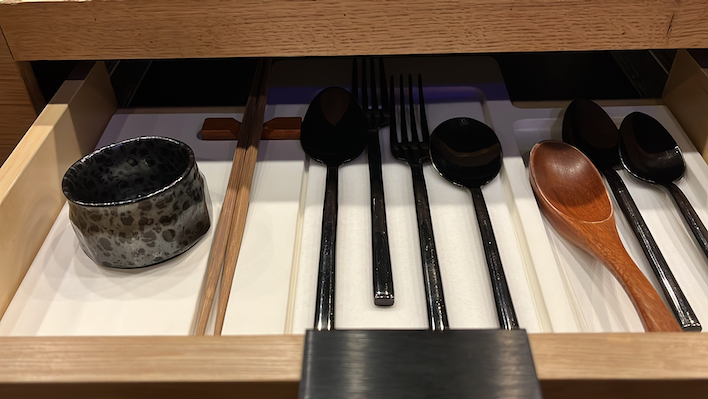
Directly in front of each guest is a drawer in which sit all of the utensils one might want or need throughout the meal, including chopsticks, spoons and, if you really must, but please try not to, forks. It’s also in this drawer at the end of the meal that the evening’s menu magically appears, a neat little sleight of hand.
The menu changes monthly, so the items I experienced won’t necessarily be offered when you dine. But you can be assured that whatever this crew serves will have the same fine quality. The current menu, while predominantly Japanese, has global influences.
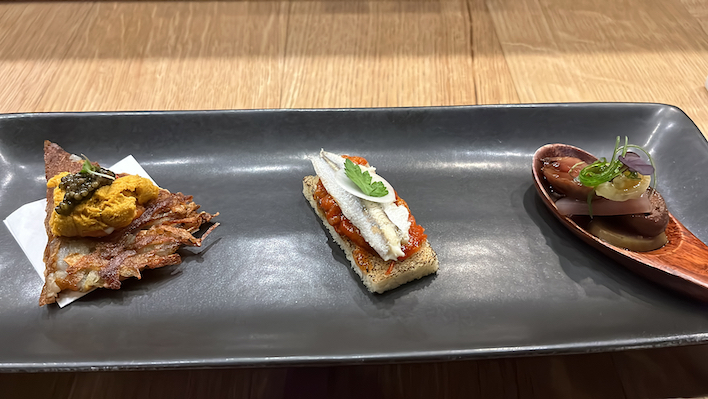
We started our meal with three small bites: a potato latke with uni and caviar; anchovy on a piquant piperade with turnip; and chicken heart with daikon and celery.
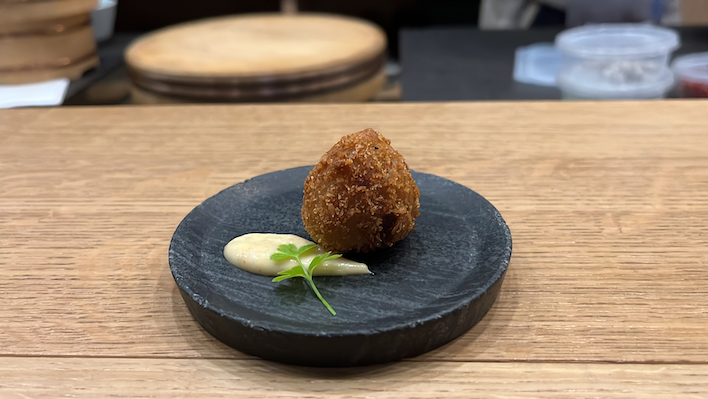
The next course was titled “Her name is Rio…” (Several of the courses have obscure names while others are more simply labeled Act I or Act II; there doesn’t seem to be much logic there.) The name is Rio, presumably, because it was a Brazilian coxinha, or croquette, with a foie gras filling. A crispy little nugget.
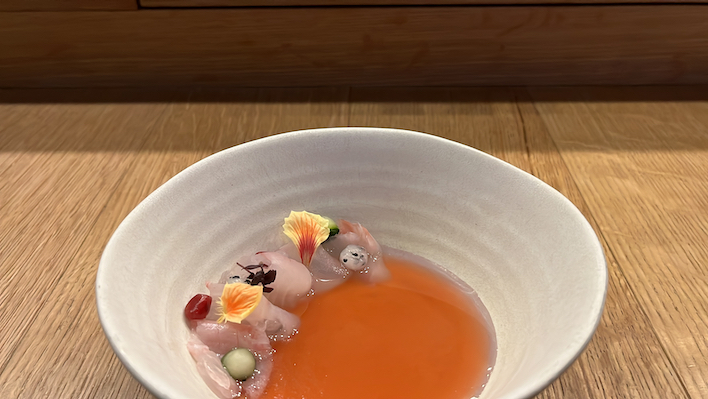
The sashimi course – “…the story ends…or you stay in Wonderland…”; apparently something to do with “The Matrix” – featured flounder in a dashi tinted with pea tendrils into which was poured a citrus juice, along with cucumber and dragonfruit.
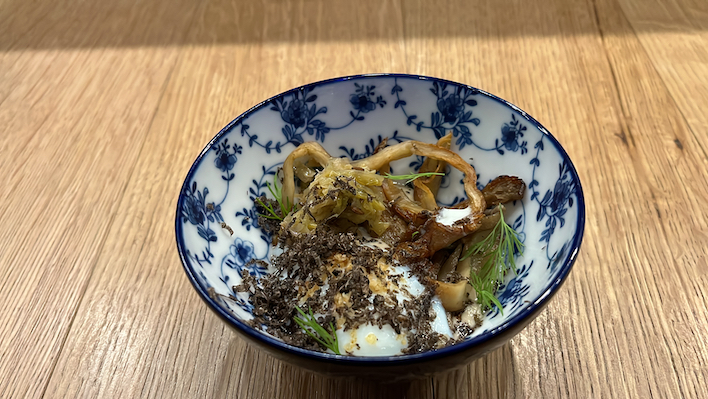
Next, “…microphone Czech One Two…”, offered a take on an Eastern European dish with mushrooms, sauerkraut with a sous vide egg. Arguably my favorite course.

Following was an intermezzo of orange sorbet, parsnip crisp and langues du chat biscuit with toffee powder.
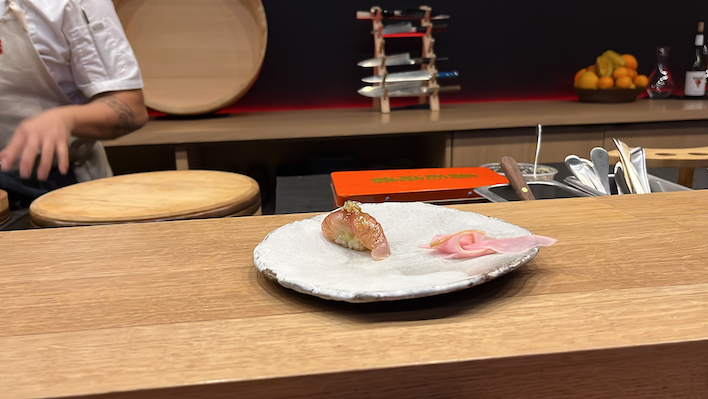
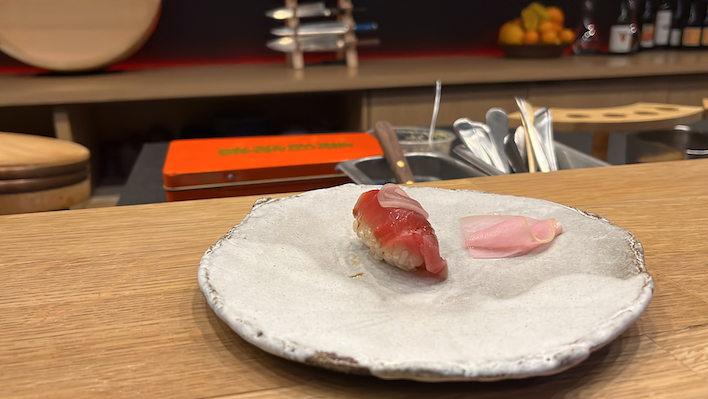
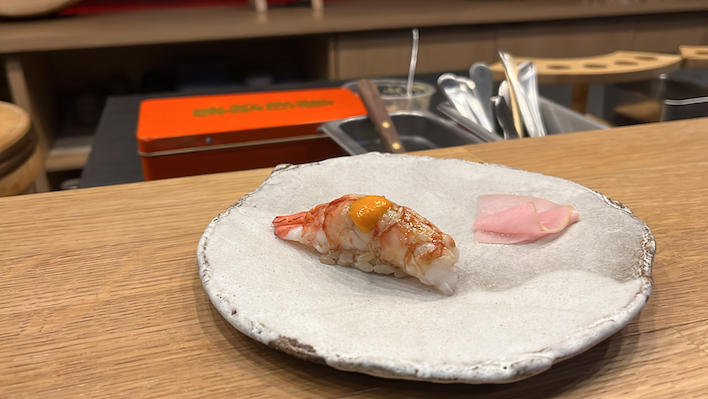
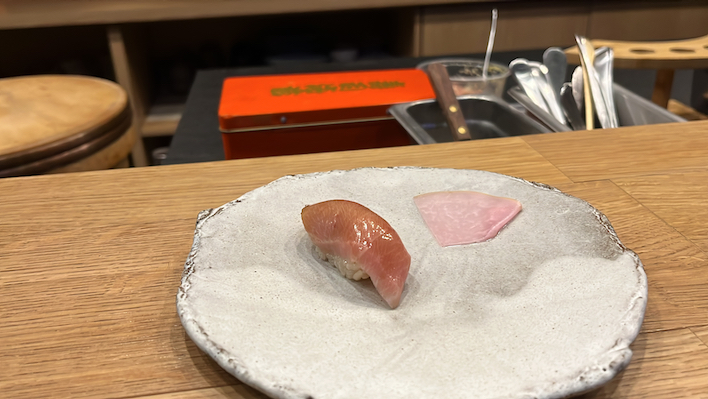
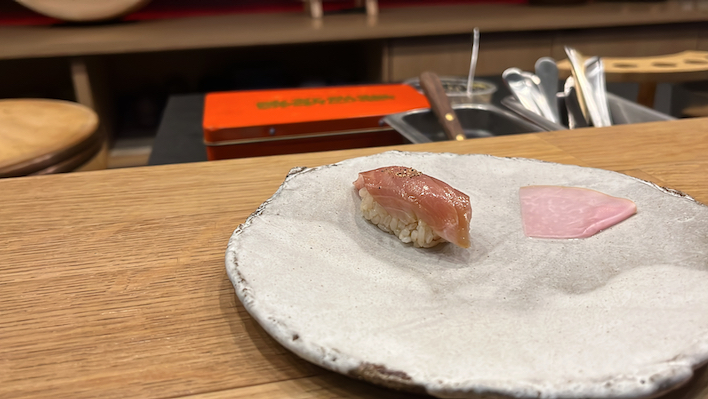
That was the palate cleanser ahead of the sushi courses – six pieces of nigirizushi – which included shima aji with garlic ponzu; itoryori with ginger scallion; bluefin tuna with pickled shallots; ebi shrimp with curry; fatty tuna toro with soy made from bones of eel and mackerel; and buri hamachi with Japanese pepper.
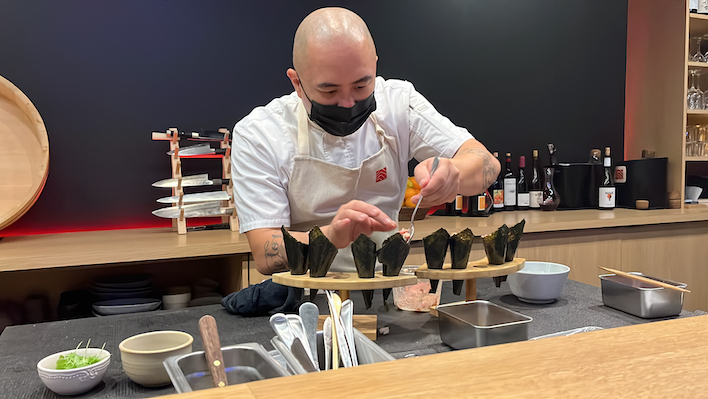
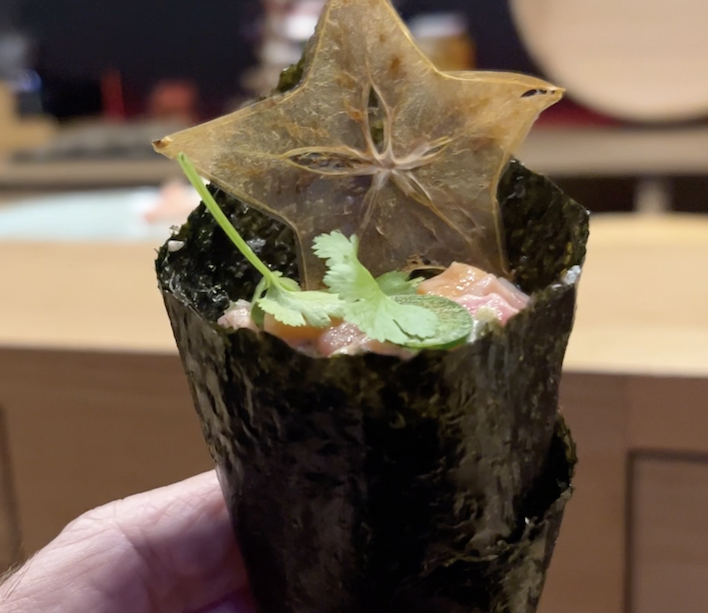
A banh mi-style hand roll featured tuna with serranos, pickled cucumbers and starfruit.
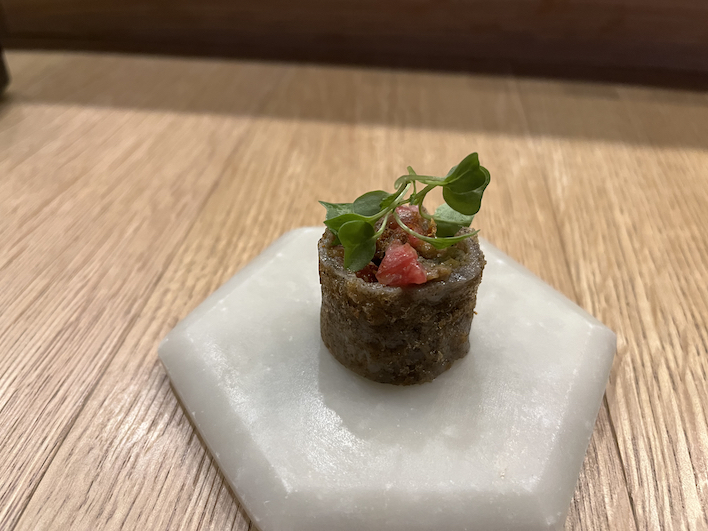
Blue Nile was a nod to Ethiopia with A5 tartare and eggplant inside an injera wrapper (made with buckwheat instead of teff).
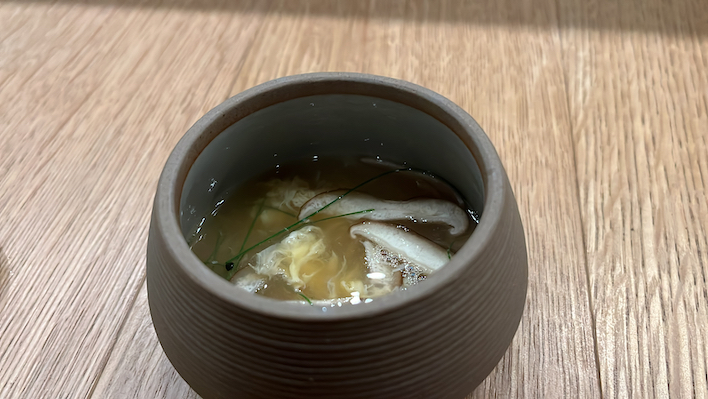
The broth course was an egg drop hot and sour with shiitake and micro chives.
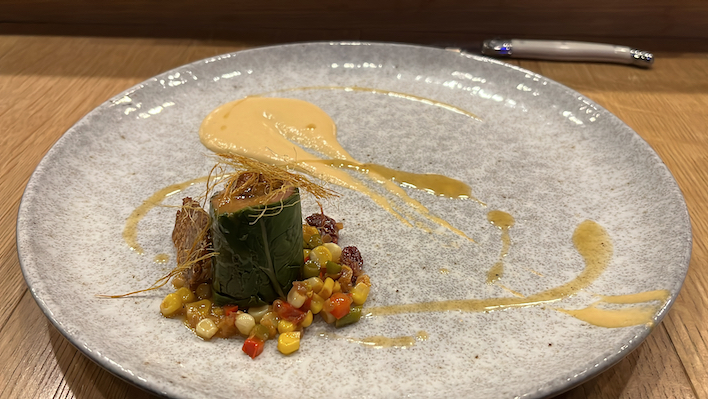
Thufferin’ Thuccotash featured a duck roulade wrapped in swiss chard topped with roasted chestnut mushroom, corn succotash, corn foam and crispy duck skin.
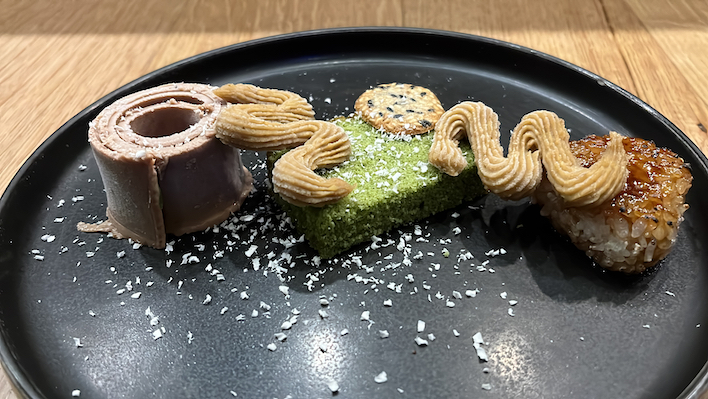
The final course, Miso Crazy, had rolled Nutella ice cream, a snake-shaped kurikinton, a matcha sponge cake, and a yaki onigiri rice ball with a honeyed coating.
Dinner for one person comes to just over $259 with tax and service charge. Beverages, including an optional wine and sake pairing, are extra. So no, this is not an inexpensive night out. Is it worth it? The quality of the food is unquestionable. You’re also paying for skill and artistry. If your idea of a great sushi experience is some miso soup, a couple of pieces of nigiri and a dragon roll, you may not see the value here.
But if you appreciate food presented with thoughtfulness by people who care about their craft – and you want to encourage and support them – then your money is well spent.
Soseki is at 955 W. Fairbanks Ave., Winter Park (map). It has two seatings Thursday through Friday.










